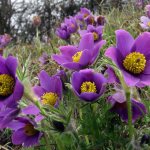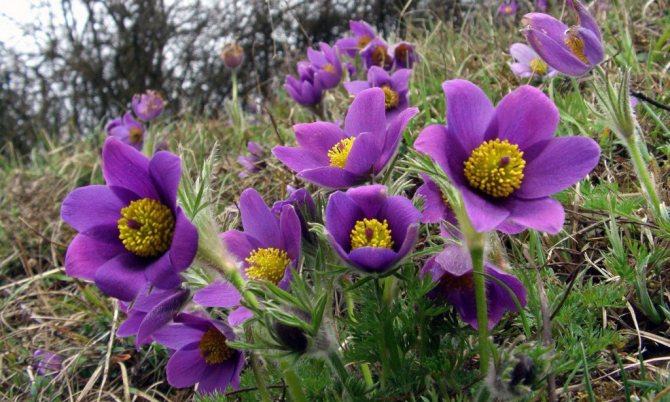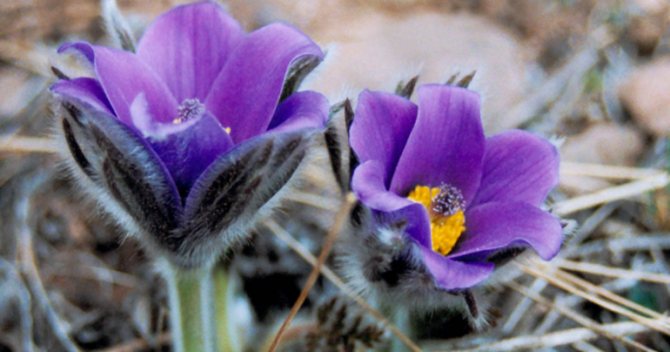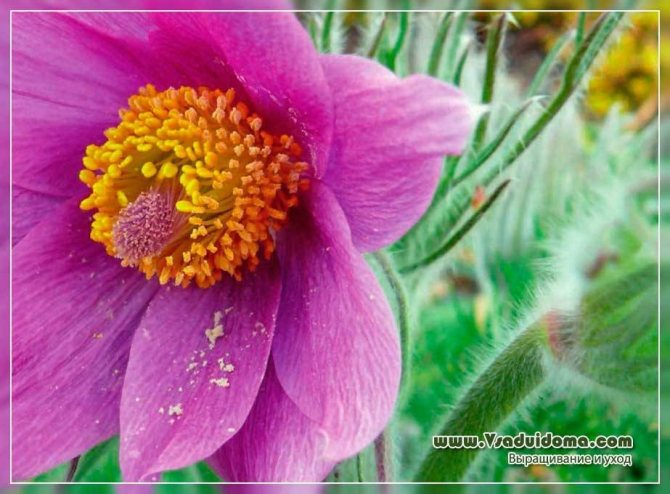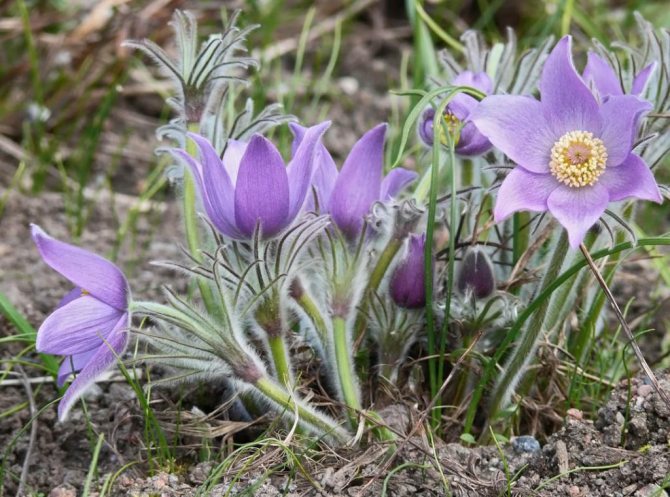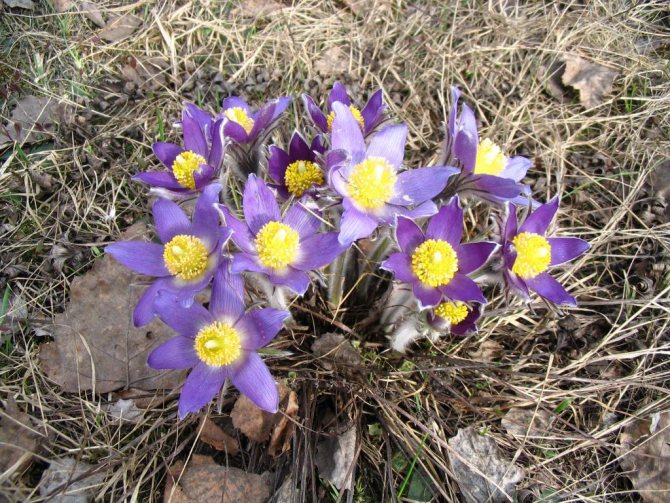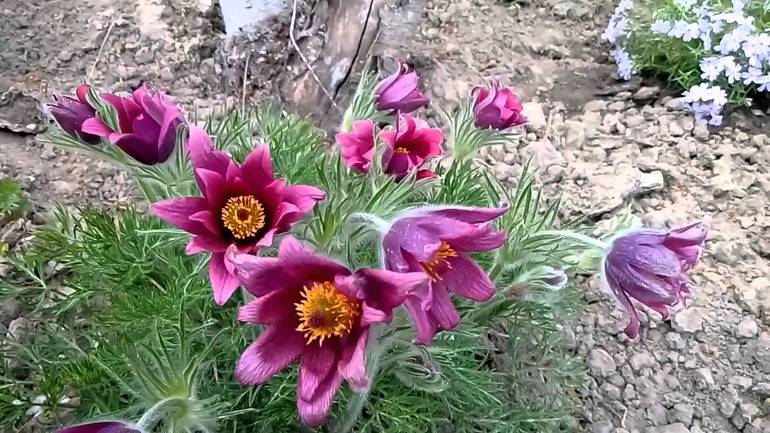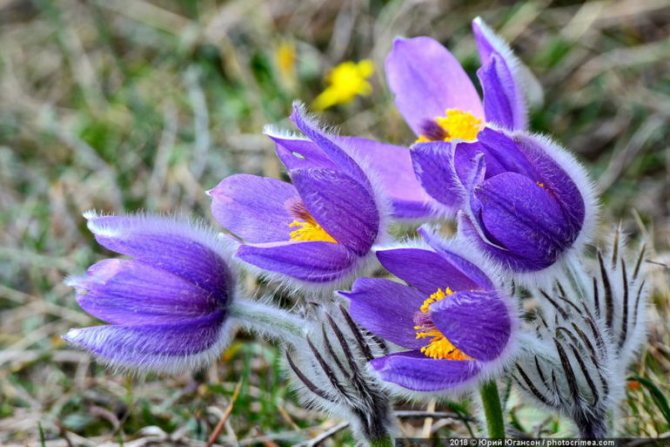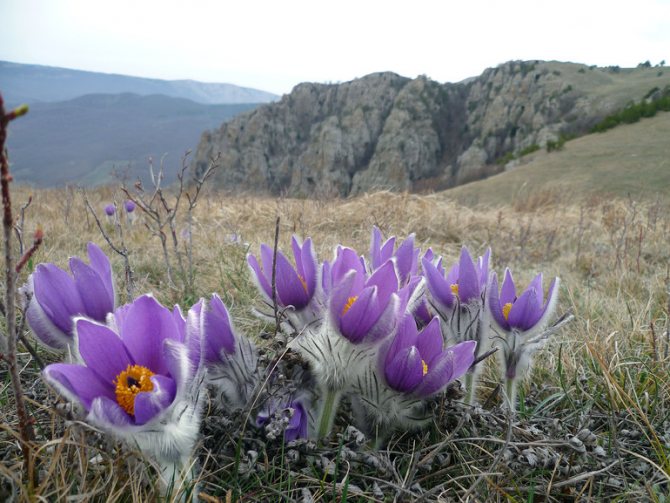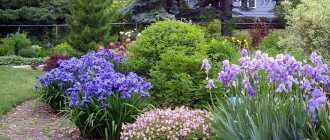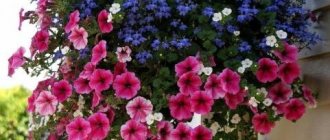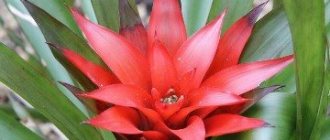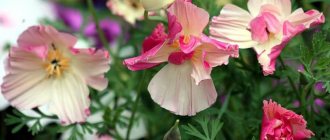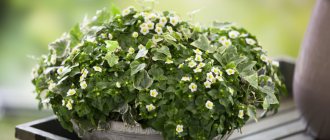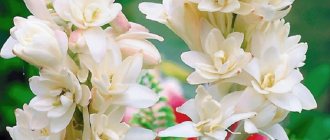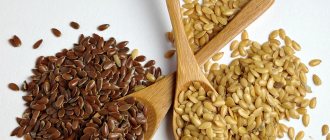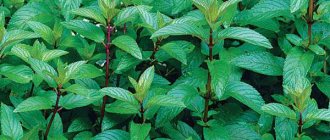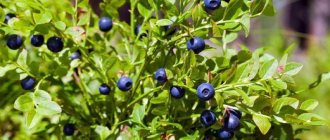Backache (Anemone patens, Pulsatillapatens) is widespread in the wild. This flower is also called open lumbago, anemone and sleep-grass. The range of the plant includes all of Europe, from its southern borders to Norway, European Russia, with the exception of the southernmost regions and the north. This flower is ubiquitous in southern and central Siberia, in the Far East, in northern China and Mongolia, in North America.
Lumbago is a delicate, beautiful and exquisite flower. This perennial herb belongs to the buttercup family. Lumbago most often grows on mountain slopes, in pine forests and on the edges of mixed forests.
The flower has branched vertical roots extending in depth and to the sides of its ground part, which grows up to 6-30 cm in height. The upright stems have dark green leaves. Rounded at the base, from the middle and at the ends, they are dissected into segments. The stems and the underside of the leaves are covered with a delicate, thin and thick pile.
All the subtleties of growing purslane from seeds. All about how to preserve osteospermum in winter can be found at the link
The flowers of the plant consist of 6-7 violet, light yellow, blue-violet, reddish or white cup-shaped petals. The middle part of the flower is collected from pistils and stamens of bright yellow color. Wild lumbago can grow and bloom for up to 20 years. The time from the entry of seeds into the soil to the appearance of the first flowers is from 2 to 8 years.
From the wild, the lumbago migrated to flower beds and gardens. Breeders have bred several dozen cultivars of this plant.
Description
The lumbago flower, which is also called snowdrop, dream-grass, anemone and pulsatilla, is a prominent representative of the Buttercup family. In its natural environment, this perennial herb can be found on rocky slopes, forest edges and meadows in Siberia, the Caucasus and the European part of Russia. There are 40 types of culture, and 25 of them are listed in the Red Book.
For cultivation in gardens and flower beds, common lumbago is often used. This shrub reaches 30 cm in height and 20 cm in diameter. It has thinly dissected, feathery leaves painted in bright green tones. At first they are very pubescent, but then they become smooth.
The plant blooms in mid-April - early May. At this time, pubescent bell-shaped buds appear on its stems. Their diameter reaches 4-9 cm. The petals are painted in violet, purple and occasionally white tones. But thanks to the efforts of breeders, varieties with red, yellow and even black buds have been bred.
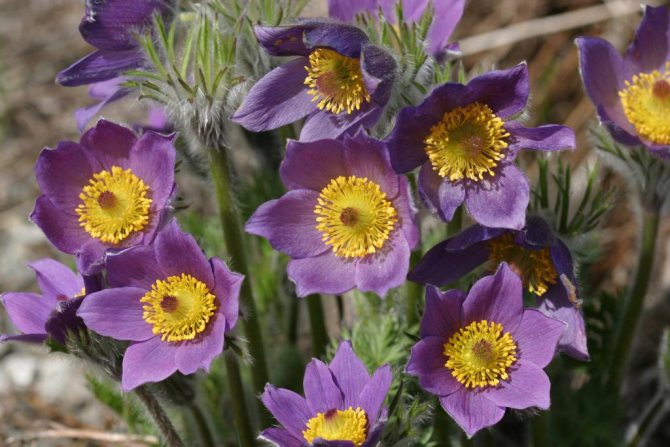
Lumbago: combination with other plants
Graceful lumbago blooms very early and is combined with other similar plants that bloom in spring:
- primroses;
- adonis;
- crocuses;
- botanical tulips.
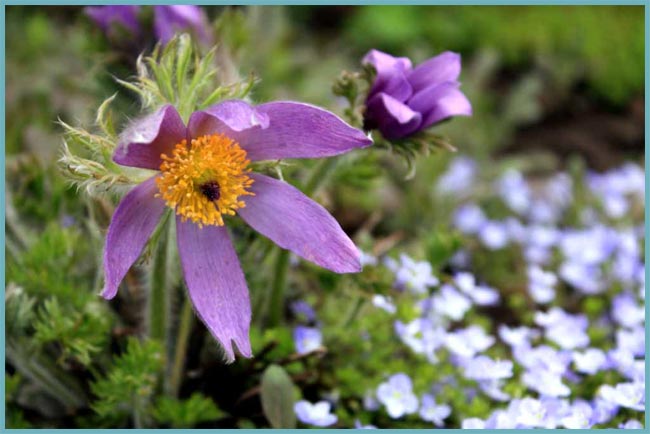

Lumbago is one of the first to bloom in the garden
The combination of different varieties of sleep-grass looks beautiful, it is favorably set off by low shrubs and trees.
The best varieties of common lumbago
Breeders have bred many varieties of this primrose. But the following varieties have gained particular popularity among gardeners:
- Rote Glocke. The buds of this variety are shaped like tulips.At the beginning of flowering, they are colored deep red, but then turn pale and turn pinkish.
- Papageno. The variety is distinguished by the large size of the buds. Their diameter reaches 7–8 cm. The snow-white petals of the culture are dissected at the tips, which gives the flowers additional volume.
- Papageno Black. This variety is appreciated by gardeners for the large size of buds up to 8 cm in diameter. The petals of the bells are painted in rich purple tones.
- Mrs van der Elst. The variety is distinguished by a pale pink color of bells. They reach up to 9 cm in diameter.
- White Swan. In translation, the name of the variety means "white swan". And this name suits the variety, because the buds of the culture are painted in a snow-white color.
- Pinwheel Dark Red Shadows. The plant grows up to 30 cm in height. It has large bells painted in reddish-purple tones. The variety is frost-resistant and suitable for growing in regions with a harsh climate.
Each of these varieties will decorate your site. In addition, the flowers of the lumbago are pollinated among themselves. And if you plant several varieties next to each other, then in 3-4 years you will get interesting hybrids with an unusual shape and bright color of the petals.
Lumbago: photo
Growing Shot Seed
The lumbago flower, the photo of which is given in the material, reproduces only by seed. Moreover, it is better to germinate the plant by the seedling method, although direct planting in open ground is allowed. But the germination of the seeds is noticeably deteriorating. In addition, sowing in open ground is carried out in the fall, and not all plants survive until spring.
Start sowing in early to mid-March. For seedlings, use lumbago flower seeds collected in the fall or purchased from a special store. But keep in mind that the fresher the grains, the higher their germination.
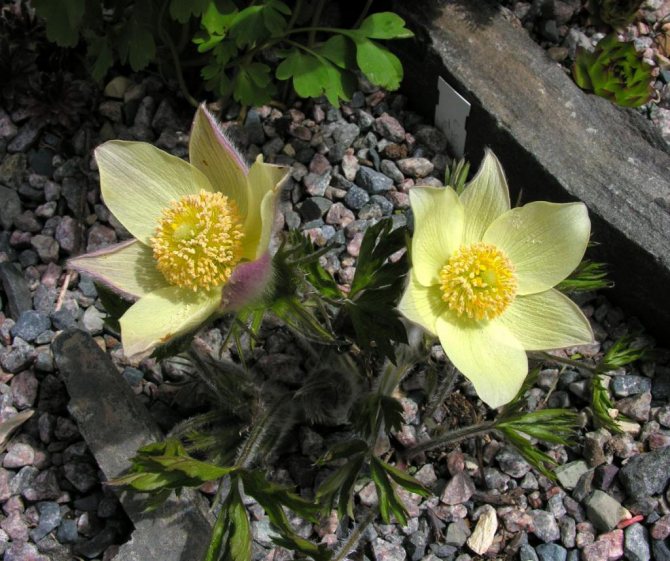

Lumbago flower
First, let's figure out what a lumbago is. These are small herbaceous plants that grow for several years. Their sizes vary from five to forty centimeters. At first, it may seem that these tiny five centimeters will be lost in your garden, but no, they are bright enough and hard to miss. Despite their small size, their root system is very strong, long and strong roots.
Summer residents call out lumbago sleep - with grass. They bloom in summer, very hardy. The shoots are always even, the greenery is not bright and not flashy. There is a peculiarity in sleep - grasses are stretching of shoots after flowering. Lumbago is loved by everyone for their huge and bright flowers that bloom to the leaves. Against the background of small leaves, these flowers seem very huge. The collection of pistils and stamens constitutes an eye, its peak comes in the spring.
The seeds ripen one month after the end of flowering. They hide in fluffy pillars. The fruits look as beautiful as the flowers. As for the timing of flowering, they bloom at different times. Some in April, others in May, some even in June. In this way, they are beneficial for your garden, as they bloom from spring to summer.
Despite their cute appearance, their healing properties, you need to remember that these are poisonous plants and you need to be careful with them. When transplanting, be sure to use gloves, otherwise you can get allergies.
Sowing
If you are sowing fresh seeds, there is no need to prepare them before sowing. Seeds one year old or older, soak for 2-3 hours in a solution of "Epin" or acid. This will increase their germination. Spread the seeds on the surface of the moistened soil, and lightly sprinkle them with sand. A layer 0.5-1 cm thick is enough.
After sowing, cover the container with plastic or glass. Place the planting in a warm, bright place. In order for the flower seeds to germinate, it is important to maintain the temperature in the greenhouse + 22 ... + 25 ° C. Ventilate the planting regularly and periodically spray the soil with warm water from a spray bottle, preventing the substrate from drying out.
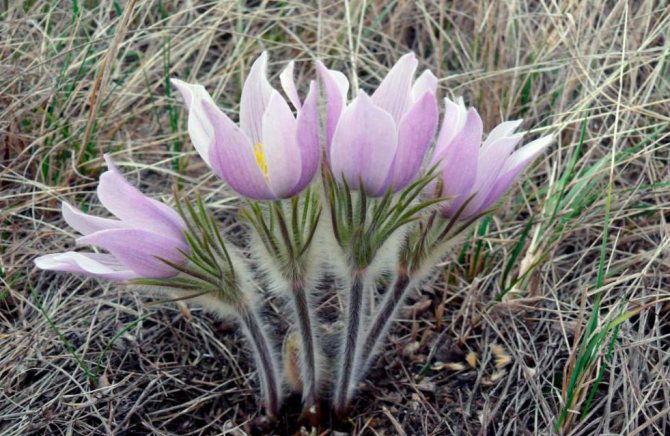

Flowering time
Shoots bloom in April-May. The fruits ripen in early summer and are also very decorative. They resemble a fluffy dandelion head (each seed has a long hairy axis), painted in grayish-brown tones, and look great against the backdrop of wonderful lacy foliage, which remains fresh until autumn.
In ornamental floriculture, many types of dream grass are used, but the most common are the types mentioned in this article.
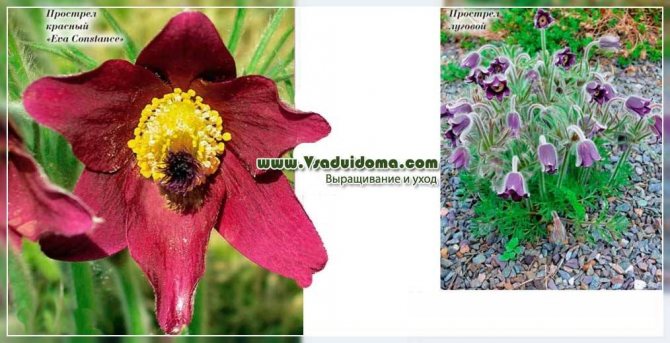

Seedling care
Under comfortable conditions, the first shoot flower seedlings appear three weeks after sowing. If this does not happen, then stop watering the soil for 14 days, and after this time, resume irrigation. This will simulate the natural conditions for the crop, which will improve seed germination.
When 2-3 leaves appear on the seedlings, dive them into a separate bowl. For young flowers of lumbago, choose deep cups or pots with a volume of 0.5 liters. Use the soil with the same composition as for sowing seeds.
Planting lumbago flowers grown from seeds should preferably be carried out next year. But you can plant seedlings at the end of summer. Then be sure to cover young plants with spruce branches before the cold weather, otherwise they will not survive until spring.
Magical characteristics
The plant is covered with an aura of mystery, because from time immemorial it has been actively used in magical practice, helped to remove damage and the evil eye, and was also used in various rituals and ceremonies, both harmless and creepy, frightening. Ancestors believed that a miracle plant is capable of endowing a person with the gift of foresight, for this it was enough only to prepare a special decoction and take it.
Other uses:
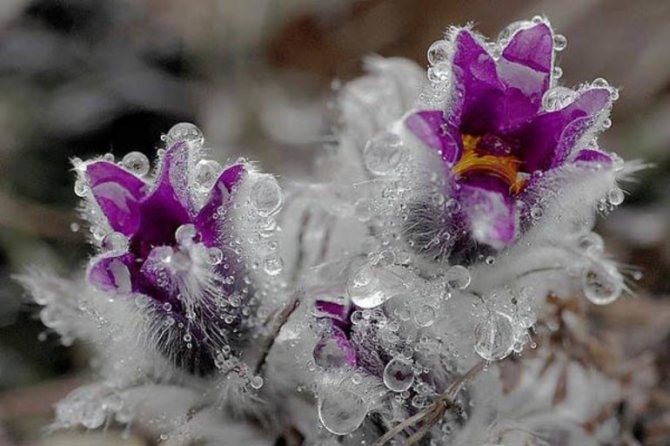

- To resist the devil's intrigues and temptations, the monks used the sap of the plant, rubbing the body with it.
- It was believed that the grass was capable of making weapons victorious, so its tips were treated with juice. There is a certain logic in this: the plant is poisonous, so it really made spears and arrows more effective and deadly.
- For the production of green paint, raw materials were used by artists.
- Wounds received in battles were healed with sleep-grass compresses.
- Putting some fresh grass under the pillow, you can see a prophetic dream.
The use of plants is diverse, for example, it is believed that if you constantly have an amulet with dried raw materials with you, it will protect its owner from evil forces and attract everything good and light.
Features of use
Often, the dream-grass, due to its delicate and touching appearance, is depicted on the pages of coloring pages for the little ones. Therefore, children get the opportunity to make its flowers purple, lavender, lilac, blue - as in nature - or to show imagination and complete a drawing in unusual colors.
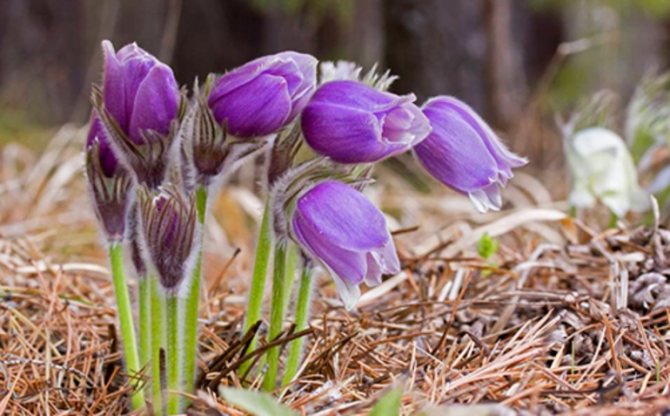

It is interesting that the postrel is one of the very first spring flowers and quite early begins to delight the region in which it grows with its bright "bells". For use for magical purposes, the plant was harvested in May, on the growing moon, in the early morning, when dewdrops still lay on the grass. It was believed that it was at this hour that it possesses the greatest magical power and helps get rid of evil spirits and the negative energy of envious people.
Putting some grass under the pillow, you could see a prophetic dream and find out your future. But the interpretation of images has its own specifics. For example, to see in the world of dreams a loved one or a young strong man, a guy for a young girl is a good sign, all her life plans will be realized, the world around her is now supportive of her. However, to see an old woman in the kingdom of Morpheus, on the contrary, promises a series of misfortunes, perhaps even death.
Charms and amulets
Like any magical flower, the arrow was often used by healers of past years as a powerful amulet and amulet.A unique representative of the flora helped in the fulfillment of desires, it was enough to constantly wear it in a dried form, placed in a small canvas bag. However, the magic herb will in no way help in the realization of evil intentions.
It is not difficult to prepare an amulet, all actions should be carried out independently. The work plan is as follows:
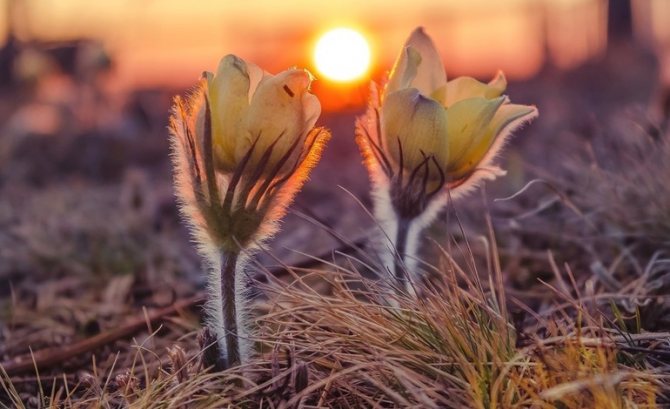

- For the growing moon, collect some grass in a forest far from the city limits.
- The best time to collect is after midnight, but before 2 am. For prophetic dreams, the collection is carried out in the morning, with dew, for the amulet, this should be done closer to midnight, when all the magic is concentrated inside the stems and leaves of plants and it keeps them in itself.
- Dry raw materials in the fresh air, but protect from direct sunlight. It is unacceptable to use modern household appliances such as an electric dryer.
- Prepare a small canvas bag (about 3x3 cm, no more), it should be sewn with white threads by hand.
- Place the dried herb, previously chopped up, into the bag and sew up.
Carry it with you, for example, in a bag (it is impossible on the neck, it is not for nothing that the plant was called a herb for sleeping, its aroma can lull or tune in to an inoperative mood), especially on those days when magical protection is required.
The topic for the post is very interesting, because there are many more fascinating facts to tell about the amazing plant. That is why it is not uncommon for elementary school teachers to give such assignments even to a whole group of children, so that several reports can be heard at once in the lesson.
Choosing a place for flowers
This plant does not tolerate transplanting well and feels great in one place for up to 20 years. Therefore, carefully choose a site for a culture and take into account its features. Lumbago is a light-loving flower, but too open areas are not suitable for it. Therefore, choose places in partial shade. It is advisable to break a flower bed on a hill. Since rain and melt water accumulates in the lowland, and from excess moisture, the plant rots and dies.
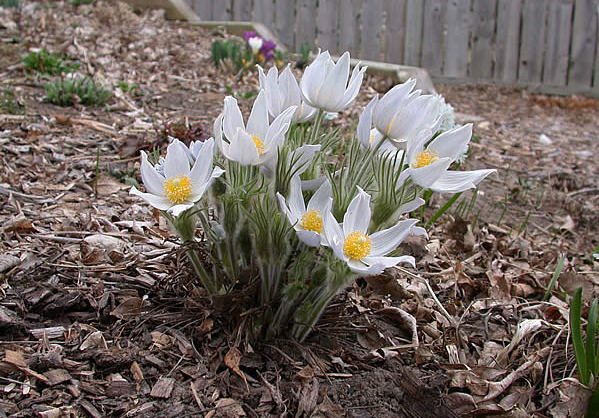

Features of the structure of sleep-grass
Lumbago - perennial grasses with a powerful vertical or obliquely lying rhizome, which goes to great depths (up to a meter or more). This feature makes the transplantation of adult specimens almost impossible. For the same reason, sleep-grass cannot be dug up in nature: it will not be possible to extract the roots without significant damage, and the plant
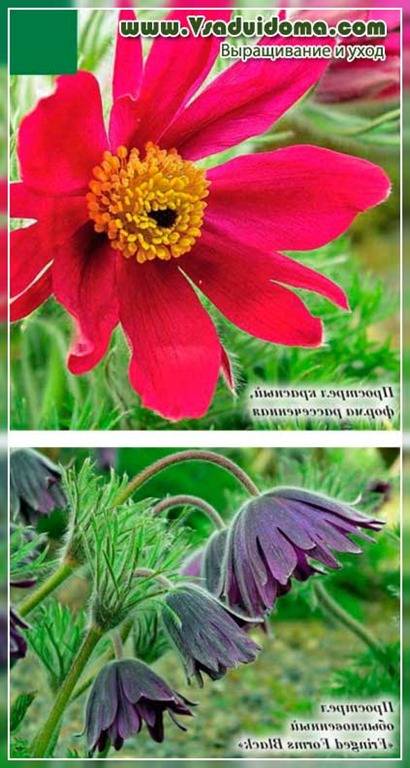

will not take root in a new place.
RARE PLANT SEEDS FOR YOUR GARDEN - FREE SHIPPING. PRICES ARE VERY LOW. THERE ARE REVIEWS


It is much easier to grow lumbago from seeds on your own or purchase planting material in a nursery. The leaves of the dream-grass are very decorative, delicate, cut into many lobes. They are collected in a lush basal rosette, but several sessile leaves are also present on the peduncle stem, forming a kind of "collar" that surrounds the flower.
Sleep grass is one of the most charming spring plants.
In most species, the leaves, stems, and even the outer surface of the petals are covered with thick, soft, long hairs. The plant seems to be dressed in a cozy warm fur coat, which, of course, is necessary for it - after all, it blooms one of the first in the wind-blown northern pine forests or in alpine meadows near the border of snowfields.
Landing in open ground
The plant prefers light, fertile loams or sandy loams with an alkaline or neutral reaction. A week before planting a lumbago, dig up the area on the bayonet of a shovel and add some sand, peat and mineral fertilizers to the ground. And it is also useful to pickle the soil with fungicides. This will protect the plants from fungal diseases.
Plant the seedlings in pits with a depth of 20-30 cm. Keep a distance of 40-50 cm between the plants. If the groundwater in the area is close to the surface, be sure to place a drainage layer on the bottom of the recesses.
Moisten the seedlings liberally and remove them from the containers without damaging the earthen ball.Plant young plants in the prepared recesses and fill the voids with soil, slightly compact the surface. Make sure that the root collar is flush with the ground.
Flower seeds lumbago
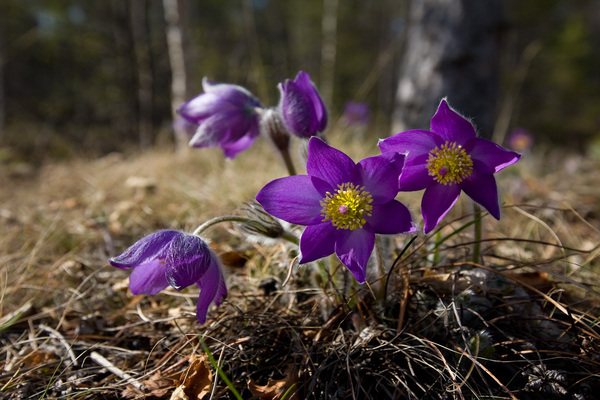

The method of reproduction in this plant is seed. For them, this is the most suitable method, since it was said above that they cannot tolerate transplantation. This is the perfect method for wildlife too. Most lumbago bloom in the second year after sowing, but there are exceptions that bloom in the seventh year, but there are few of them.
When sowing, you need to remember that they do not tolerate transplants, the lumbago simply will not survive. It is best to plant them in the spring, although some plant them in the summer, but this is a risky step. Sowing into soil is no different from sowing other seeds, the strategy and rules are the same. They are pressed into the ground, keeping a distance, poured with water and ready. It is worth remembering that the arrow will bloom only in the second year of planting.
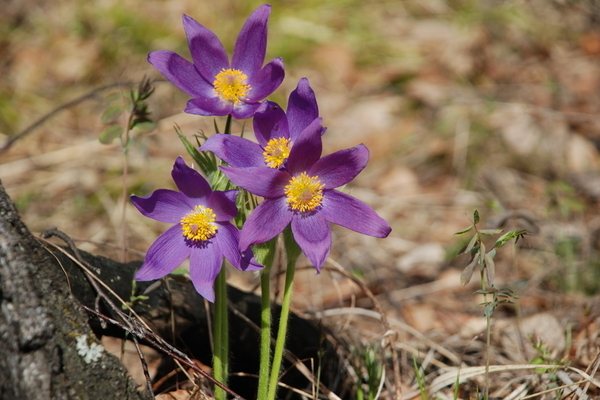

Lumbago photo
Sowing flowers directly into open ground
This growing method is justified if you do not want to waste time on seedlings and you have a lot of lumbago seeds, because not all of them will germinate. Start the event in late June - early July. If you have high-altitude varieties of lumbago, then sow them in the fall.
Prepare the plot in the same way as when growing by the seedling method (see "Planting in open ground"). Plant the seeds in a thick layer to a depth of 1.5 cm. To prevent future plants from overheating and overcooling, cover the planting with straw. The first seedlings will hatch in 20-30 days. Provide them with routine care in the future.
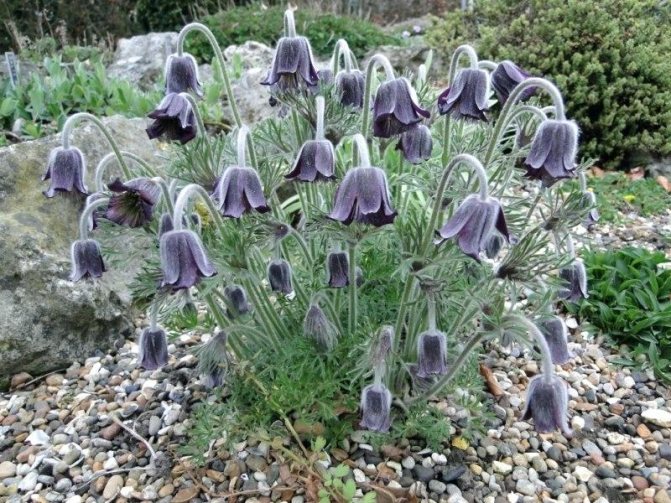

Backache in landscape design
Lumbago is a great plant for landscaping. It is present in almost all photos of landscaped gardens offered by designers. The plant is beautiful and in the form of a lonely standing bush, and growing in groups.
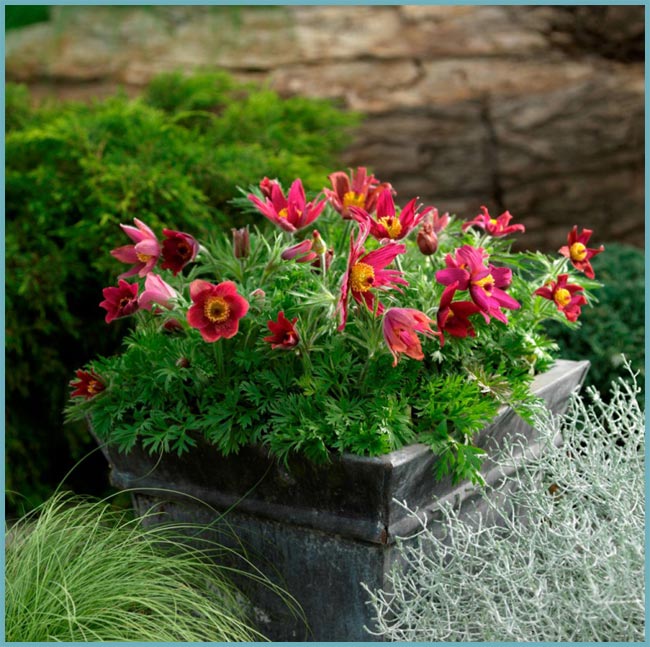

Backache in landscape design
If you want to settle a lumbago in your suburban area, never dig up a wild plant - it will definitely not take root in you, and you will cause great damage to nature. Plant some seeds and a rare crop is sure to beautify your garden.
Watering
Lumbago is a drought-resistant plant. Primrose tolerates waterlogging much worse than lack of moisture. But it is impossible to allow the soil to completely dry out. Therefore, moisturize the plants occasionally during the dry season.
Young seedlings need more moisture, because it helps the flowers to take root well. Water the plants frequently during the first two years after planting. But do not get carried away in order to prevent stagnation of moisture at the roots. Irrigate strictly at the root. It is advisable to use melt or rainwater, or pre-defend tap water.
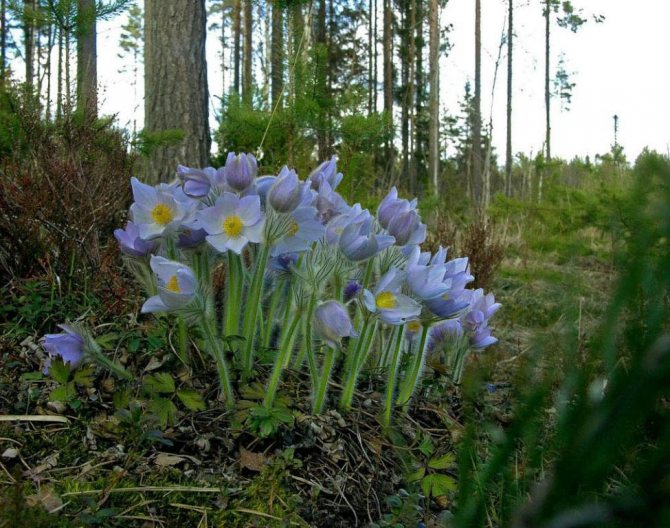

SHOOTING OPEN
The open lumbago (Pulsatilla patens) has a vast area that covers Europe, the European part of Russia, the south of Western Siberia, China, Mongolia, some regions of Canada and the United States.
The plant is 7-15 cm tall, when fruiting, the stems can grow up to 40-50 cm. The flowers are blue-violet, at first wide bell-shaped, later wide open, star-shaped. Flowering occurs in April-May and lasts up to 3 weeks.
Adult strong specimens can produce up to 40-50 flowers per season.
The species is quite plastic. It can grow on moderately moist and dry soils of varying degrees of fertility, tolerates short waterlogging. During the flowering period, it requires good illumination.
Loosening and mulching
The next day, after watering or rainfall, be sure to loosen the soil near the flowers. Otherwise, a crust forms, blocking air access to the roots. And this has a bad effect on the decorative effect of the lumbago flowers. Gently loosen the soil to a depth of 5–10 cm.
Remember to remove the weeds while loosening. Run the event manually so as not to damage the crop shoots with garden tools.
To prevent rapid evaporation of moisture, mulch the surface of the flower garden with sawdust or humus.This layer will reduce the care of plants, because watering and loosening the soil will have to be less frequent. In addition, mulch will prevent the growth of weeds and nourish the seedlings with useful substances.
Lumbago flower care
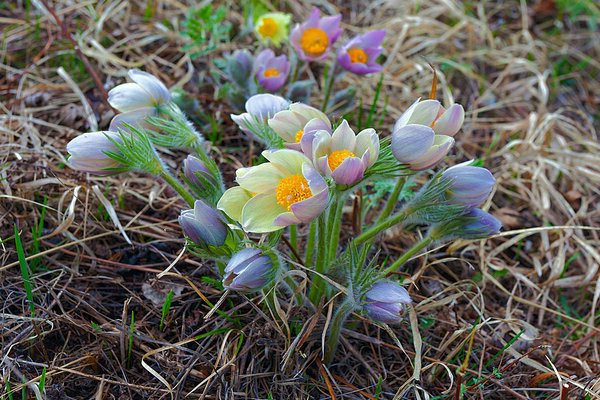

They do not require any special care, they are not capricious and easy to care for. They adapt well to almost any climate. Frequent watering is needed only in case of drought; in normal weather, they do not require frequent watering. Top dressing is also encouraged before flowering. Fertilizers must be applied without nitrogen, this point is worth remembering.
Diseases and pests
Lumbago is a flower with strong immunity. But occasionally he gets sick with a black leg. It is quite difficult to treat this disease, so it is better to prevent it. To do this, pre-pickle the soil where you will plant primroses with fungicides.
In winter, the primrose can be gnawed by rodents. To prevent this from happening, use the poisons "Tornado", "Amus" or "Testox" to protect the plant. But when working with drugs, be extremely careful and strictly follow the instructions for use.
Of the insect pests, sleep-grass is annoyed only by slugs and snails. Use Thunderstorm or Slime Eater insecticides to control these parasites. Eggshells also help protect the flower from pests. It needs to be pounded and scattered over the surface of the flower garden.
Growing an attractive primrose in your backyard is not that difficult. The main thing is to provide proper care for the flower of the lumbago and create comfortable conditions for it. He will surely thank you with attractive delicate buds that will delight the eye every spring.
Beneficial features
When working on a short story for presentation in the lesson, you should pick up interesting facts about the sleep-grass, in particular, about the amazing healing properties of this plant. Lumbago has sedative, sedative, antimicrobial effects, helps to normalize blood pressure, relieves heart palpitations. However, it is used exclusively in folk medicine, preparations containing plant elements are not produced in pharmacology.
Other effects:
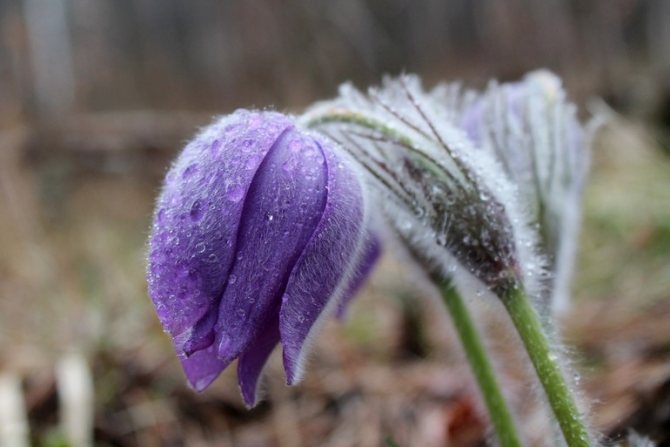

- It is used to treat joint pain and skin fungus; for this, lotions and compresses are made.
- Broths are drunk for insomnia, headaches, neuroses, tantrums.
- Allows you to alleviate the patient's condition with pneumonia.
- Vodka tincture is used for rheumatism, it is rubbed with the affected parts of the body.
- For the treatment of burns, it is customary to boil fresh grass in a Russian stove, collecting the resulting juice, which is used in therapy.
However, do not forget that handling a poisonous representative of the flora requires caution, otherwise you can get poisoned, get severe irritation or a burn, similar in symptomatology to a chemical of the second degree.
Contraindications include: pregnancy (there is a risk of losing a child), pathologies of the digestive tract, ulcers, inflammation. Children under 3 years old should refuse treatment with herbs, as well as those who have an allergic reaction to plant components. It is also not recommended to use lumbago for arrhythmia and hypertension.
Healing properties
Lumbago has a valuable chemical composition, due to which it has the following properties:
- pain reliever;
- astringent;
- calming;
- antispasmodic;
- sedative;
- anti-inflammatory;
- fungicidal
- bactericidal;
- diuretic;
- choleretic;
- bronchodilator;
- enveloping;
- locally irritating;
- hypotensive;
- healing.
Among other things, preparations based on the lumbago extract are used in the treatment of alcoholism to relieve painful conditions during the first days of refusal from alcohol. Alcoholic tinctures of dried flowers are used to increase male potency.
List of indications
Sleep herb and its derivatives are recommended for use when:
- disorders of the nervous system, accompanied by insomnia, overexcitation, migraines, anxiety, depression.
- bronchitis, whooping cough, bronchial asthma and other diseases of the respiratory system, requiring the use of expectorant drugs and antispasmodics as therapy;
- menopause, PMS, the plant is especially effective against cramps in the lower abdomen during menstruation;
- diseases of the cardiovascular system, but strictly after consultation with a specialized doctor;
- open wounds, cuts, burns of varying degrees, fungi, eczema, dermatitis;
- problems with the genitourinary system and male erection;
- pain syndrome;
- inflammation of the joints, rheumatism, gout.
Some doctors have hypothesized about the positive effect of lumbago on the condition of people with oncology. But there is no official medical research on this yet, so it is impossible to speak with confidence about the treatment or prevention of cancer with the help of this plant.
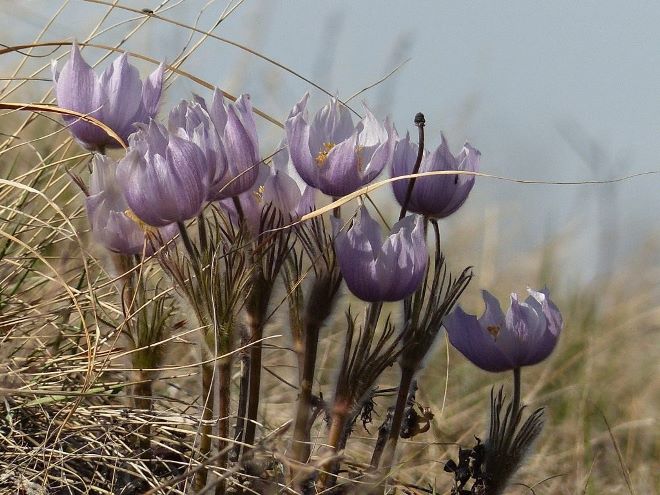

lumbago is used for the preparation of medicinal products - infusions, decoctions, teas, which are used in the treatment and prevention of various diseases
SHOOTING GALLER
Haller's lumbago (Pulsatilla halleri) occurs naturally in the mountainous regions of Central Europe and in the Crimea. The plant is 10-15 cm tall. After flowering, the stem can lengthen up to 30 cm. It blooms for a month at the end of April-May, until the leaves appear. Corolla 5-6 cm long, purple, fading as it blooms. Easily propagated by seeds, young plants bloom in the 5-8th year. Winter-hardy.
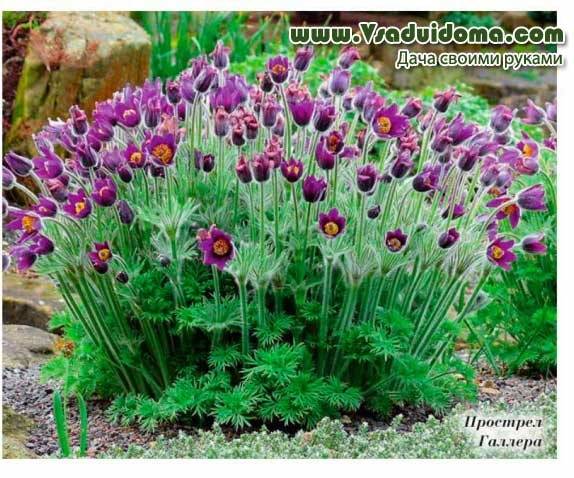

Useful and harmful properties. Contraindications
Sleep grass contains some active active ingredients that have both positive and negative effects on the human body:
- Protoanemonin and ranunculin are corrosive volatile substances that irritate mucous membranes. They can cause poisoning, swelling and allergies, while being powerful natural fungicides and bactericides.
- Saponins are non-nitrogenous substances with a complex structure that irritate mucous membranes and are toxic to the body. Taken in the correct concentration, they have an expectorant, diuretic and cardiotonic effect on the human body.
- Vitamin C - has a general strengthening effect on the immune system and improves the general condition of a person.
- Tannins - this is the name of the phenolic group of chemical compounds that inhibit the development of pathogenic microorganisms, providing an anti-inflammatory effect.
- Resins are complex compounds of chemicals contained in lumbago resins that have analgesic and sedative effects.
Being a medicinal plant, lumbago has both medicinal properties and contraindications. Since the effect of the herb on the body of pregnant and lactating women has not been sufficiently studied, during the period of gestation and lactation, the use of medicines and traditional medicine based on this plant should be abandoned.
It is contraindicated to use the plant lumbago for the treatment of patients with diseases of the gastrointestinal tract, especially for people with impaired liver function.
Pathologies of the kidneys and genitourinary system are also considered contraindications to the treatment of lumbago.
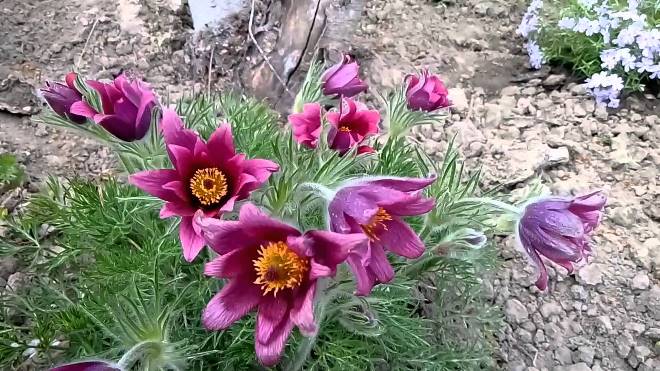

the rich chemical composition of the plant helps to maintain human health, providing a healing effect
External appeal
A plant with flowers with six pointed petals of purple or lilac color is an open lumbago. Its root system is vertical, multi-headed. In the lower part of the stem, basal, pinnately dissected leaves are formed, and thin and long simple stem leaves grow together at the bases. Both those and others are covered with a light down. Each individual plant at the top of the stem forms one large flower, shaped like an erect or lowered bell.
general information
Description: sleep grass is a low plant up to 20 cm high, with a powerful vertical brown rhizome.The leaves are rooted, on long, hairy cuttings, at first the same hairy, but later become naked. They grow after flowering and dry up in autumn.
Flower lumbago.
The flower stalks of the plant are straight, the flowers after blooming have the shape of a bell, and later become like stars. Petals 3-4 cm long, pointed, straight, blue or purple in color. Hairy on the outside and smooth on the inside. The stamens are yellow. In place of flowers, after flowering, rounded, hairy fruits with seeds are formed. Silvery fluff makes them look like light, balloons, thanks to which the lumbago is beautiful both during flowering and during fruit ripening.
Sleep grass grows well on podzolic soil in mixed and coniferous forests, on heather heathland, in shrubs and on forest slopes.
Growing lumbago - the experience of summer residents, advice and reviews
Sleep grass will wake up spring
Lumbago, pulsatilla or sleep-grass - under these names we know this wonderful spring plant.
A gentle, fluffy flower is the first in my garden to announce the beginning of spring. Try and grow this little miracle.
Sowing lumbago
Several years ago, the lumbago went to a permanent sunny place before winter. I dug the soil deep, because the roots of the lumbago are very long -40-50 cm. The soil must be fertile and loose, so I added compost. The seeds were sealed to a depth of 0.5-0.7 cm.
Advice
If there are few seeds, then stratification can be carried out: in February, place them in wet sand for 4-6 weeks, and then germinate at room temperature in pots, followed by transshipment into open ground.
Sowing can be carried out in the spring immediately into the ground (but keep in mind that seedlings will appear in a few weeks, and some - only the next year).
Seedlings and seedlings
In the first days of May, friendly shoots appeared. All summer I took care of the seedlings: I watered, loosened, fed them once with a complex mineral fertilizer, and shaded them from the bright sun. By the fall, there were 3 delicate dissected leaves on the seedlings.
First wintering and spring
The plants spent the first winter under the shelter of pine branches. In the spring of next year, I was pleased with strong seedlings with silvery pubescence and even 2 shaggy buds.
The buds grew rapidly in the sun and soon turned a bright blue-violet color. Blooming lumbago delighted me for 3 weeks, then leaves began to develop vigorously.
Beauty all season
Sleep grass does not lose its attractiveness throughout the season. The plant attracts the eye with rather large flowers (up to 5 cm in diameter), pubescent stems and buds, carved lush greenery,
Important
The seed germination rate depends on the storage period. The faster they sowed after collection, the more amicable the seedlings.
decorative until late autumn. In June - July, lumbago curtains are covered with tufted caps made of pubescent seeds.
In the spring of the third year, after the snow melted, clusters of hairy buds appeared. When they blossomed, my joy knew no bounds. Purple, white, creamy yellow and cherry blossoms are a miracle!
Division and transplant lumbago
The plant eventually grew into a large clump. I decided to have her sit down. It took a lot of work: the roots turned out to be so powerful, as if I were uprooting an old bush. The division of the curtain was carried out in early spring before the appearance of the leaves.
For planting delenoks (large - 4-5 buds), I dug deep holes so that the root spreads out to its full length. I watered the plantings and shaded the first 2-3 days from the bright spring sun.
Shoot care in the fall
Sleep-grass gives a strong self-seeding, and if there is no task to collect my seeds, I cut off the faded flowers. In the first years I did not perform this operation, and in the spring around the curtain, shoot seedlings sprouted like "moss".
In late autumn, I must cut off the foliage so that in the spring the plant does not lose its decorative effect (removing dry leaves in the spring, you can damage the buds), so that the flower buds do not get pushed up and to deprive the mice of warm wintering.
Lumbago is a strong, unpretentious plant.For all the time that the dream book has been growing in my garden, it has not been damaged by any insects, and it has never been sick. This adorable spring flower will take its rightful place in your garden.
NOTE: THE BENEFITS AND HARMFULS OF A SHOOT - HERBALIAN TIPS
Opened lumbago, or sleep-grass (Pulsatilla patens)
Growing
Loves open, sunny places, light shade is acceptable.
In the first year after planting, the plants need to be covered with spruce branches, then it winters well under the snow and without shelter.
The optimum soil is sandy.
Waterlogging, as well as excessive drying of the soil, the sleep-grass does not tolerate. Therefore, watering is needed only in drought.
The plant is planted in an open place, only a small shadow is permissible.
Before planting sleep-grass, the soil must be well fertilized. The plant loves lime, responds well to nitrogen, it needs potassium and phosphorus.
The younger the sleep-grass, the easier it tolerates a transplant, adult plants take root poorly. The easiest way to propagate the lumbago is by seeds. They usually ripen in July, there is no point in harvesting them before.
For migraines, coughs, bronchitis, bronchial asthma, whooping cough, nervous overexcitation, insomnia, irritability, hysteria, benign prostate tumors, painful menstruation, to reduce premenopausal manifestations.
Stonecrop Recipes
2 tsp dry grass lumbago pour 1 tbsp. boiling water, boil for 15 minutes. in a water bath, cool at room temperature, strain and squeeze, add boiled water to the original volume. Take 1 tbsp. 3 times a day.
For rheumatism, arthrosis, arthritis, gout (infusion for applying lotions to the affected joints) 1 tbsp. pour the herbs with 1 tbsp. boiling water, leave for 12 hours, strain.
Stonecrop contraindications
Individual intolerance, periods of pregnancy and lactation, gastric ulcer and duodenal ulcer, diseases of the gastrointestinal tract and kidneys, age up to 12 years - with caution.
This is a poisonous plant, so use it only as directed by your doctor, strictly observing the dosage!
My lumbago
It is often written that the lumbago does not tolerate reproduction by dividing the bush. And I decided to check this for solidification, although I knew that the plant does not like transplants and can grow in one place for a long time.
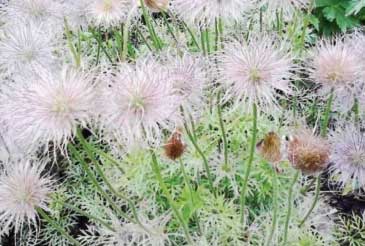

At the end of August, she divided a three-year-old sleep-grass bush. It turned out to be eight divisions. I planted them in different parts of the garden, adding to the fertilizer “Kemira. Autumn ”, and watered well. Then I monitored the moisture content of the soil. In the spring, all the bushes came out from under the snow alive, and most importantly, five of them bloomed. So I realized that the lumbago can also be propagated vegetatively, it is only important not to divide the bushes in late autumn (in a warm, prolonged autumn - no later than October) and create
Good conditions.
After flowering, seeds are formed that ripen in early August. It is better to sow them in the same fall while they are fresh. During the winter, the seeds will undergo natural stratification in the garden.
Sowing seedlings
The seeds were sown for the first time in the second half of February. The container was filled with peat, spilled with "Fitosporin" (10 drops / 1 tbsp. Water). I spread the seeds, sprayed them with Epin water (0.5 ml / l of water) from a spray bottle, covered them with 4-5 mm sand and sprayed them again. I left it for a couple of hours to soak the soil. Then she wrapped the container with polyethylene and put it in a dark room with a temperature of 0- + 5 degrees, for stratification (you can put it in the refrigerator).
Around the beginning of March, I removed the film and put the crops on a warm, light windowsill. Amicable shoots appeared in 2 weeks.
The main thing in further care is not to forget to water. When a pair of leaves appeared, seedlings dived. Over the summer I fed three times with liquid fertilizer "Barrel and 4 buckets" (according to the instructions). In early August, I landed at a permanent place. Seedlings bloom in the third year. Lumbago prefers a bright place and fertile soil. It does not tolerate stagnant water, but needs to be moistened as it dries up. Hibernates without shelter.
Anastasia G. St. Petersburg. Photo by the author
ORDER QUALITY AND CHEAP SEEDS AND OTHER PRODUCTS FOR HOME AND COTTAGE. PRICES ARE BOTTLE. CHECKED! JUST LOOK FOR YOURSELF AND BE AMAZED HOW WE HAVE REVIEWS. GO >>>
Below are other entries on the topic "Cottage and garden - do it yourself"
- Sleep grass or lumbago - planting and reproduction: Plant sleep grass or lumbago Sleep grass, ...
- Sowing shot with seeds - PROVEN methods: It is safer to grow a shot from seeds, ...
- Sleep-grass and plants of the genus lumbago: Growing sleep-grass and other lumbago early ...
- 10 first flowers - early flowering plants: What flowers bloom first After leaving ...
- Common lumbago - planting, care and reproduction (including by seeds): How to grow lumbago (anemone) Any florist ...
- How to grow godetia: Godetia flower - photo and ...
- How to cut shrubs correctly: Cutting and shaping shrubs - ...
Subscribe to updates in our groups and share.
Care
Usually, the flower has enough moisture from the melted snow, and it is not required to water the flowering lumbago. But, if a winter with little snow and a dry spring happened, the lumbago is regularly watered, well moistening the soil in the flower garden. By the end of summer, watering is reduced.
The entire period of active vegetation, every 20 days, the sleep-grass is fed with phosphorus-potassium fertilizers for snowdrops or bulbous. The dose of powder is halved compared to that recommended by the manufacturer.
It is undesirable to transplant an adult plant lumbago, its roots are too fragile. In case of urgent need, a plant with a large clod of earth is moved in early spring or late autumn (when the first frosts already seize the soil).
The flower tolerates winter well, it is not required to cover it. In the summer, the soil can be mulched with gravel chips, peat, wood shavings of deciduous trees.
Lumbago is not affected by diseases and pests. Only with excessive moisture can the roots of the dream-grass rot.
Name
Pulsatilla is a perennial plant in the Buttercup family, which belongs to snowdrops or primroses. Translated from Latin, the name of the flower means "wiggle" or "wobble", indicating how the flowers of a plant sway in the wind. Another name for pulsatilla - "sleep-grass" characterizes the appearance of the flower: a fully open bud tilts downward, as if falling asleep. Preparations made with the use of herbal raw materials lumbago have a calming and hypnotic effect. In early spring, the shoots of pulsatilla appear on the surface of the earth with green “awnings”, as if shooting out of the soil, hence the other name - lumbago.
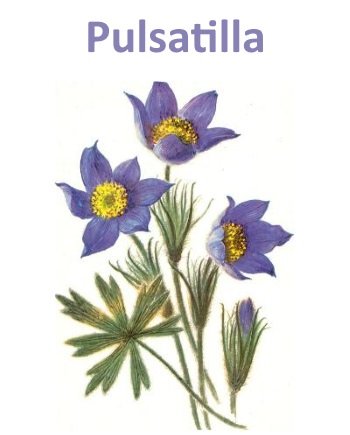

Pulsatilla
The magical properties of the plant
Many people believe not only in the healing properties of the dream herb, but also in its magical power. She protects from the evil eye and all sorts of witchcraft effects on a person.
There are many legends about this plant. So in ancient times it was said that the one who fell asleep in the sleep-grass automatically acquires the gift of prediction and foresight.
There are a lot of prescriptions for collecting sleep herbs. An indispensable condition that must be fulfilled when going to collect sleep-grass is purity of thoughts. It is believed that grass collected with dew has special properties, and after that it has lain until noon in cold water.
If you put such a collection under your pillow, you will definitely have a prophetic dream. It is better to collect herbs in solitude and silence, if in the process of making a wish, it will certainly come true. And dried sleep-grass promises wealth and a happy life for the owner.
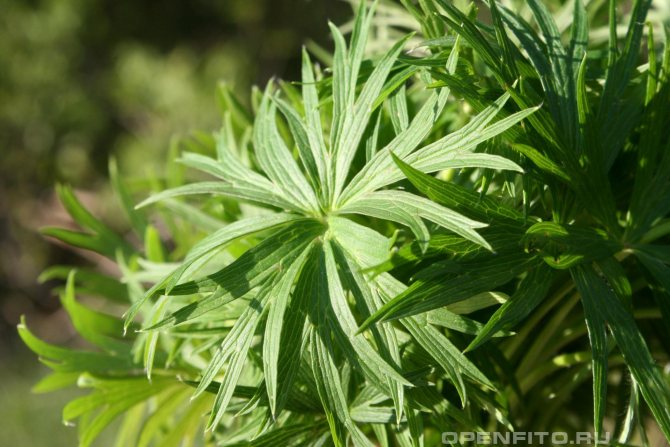

The medicinal properties of sleep-grass have been noted since ancient times.
Disappointed in the effectiveness of traditional medicine, or not wanting to contaminate their bodies with chemicals, many resort to the healing properties of this humble purple flower.
Buy lumbago in the store
In 2019, the Ivanovskie Herbs company launched an experiment on growing sleep-grass (lumbago), and also took up the issue of the distribution of this plant throughout the Ivanovo and neighboring regions.
This year we managed to collect several kilograms of flowers, shot grass and seeds. You can buy them in our store.
Tags: Backache
Updated: 29 January 2019.
... Category: Interesting articles about plants
Compositions in the garden
Flowering in lumbago earlier, it looks good with various shrubs and trees, it looks elegant in the garden. It is also combined with spring flowers, for example, with spring adonis, crocuses, primroses. They are planted along the paths. You can just take several varieties of this plant or try to grow a whole group. Don't dig plants and transfer them from their natural habitat, since they will not survive the transplant anyway.
Planting and growing a plant
The lumbago is planted in a flower bed, where perennials coexist; an alpine slide and rockery are also suitable. The plant does not tolerate dampness! You need to choose a place for lumbago with light shading, but in sunny places, the culture also feels good. Place the flower on the south side of the garden. It is great if the selected place is with a slope that will not allow water to stagnate. Since the seeds are sensitive to light, it is best to cover them with a layer of soil, but not too much. Plant care:
- The lumbago needs to be fed. Fertilizers containing lime and nitrogen are suitable for this. Potassium-phosphorus fertilizing is also necessary, but they are applied only twice per season. There are chances and in poor soil, lumbago is able to grow from seeds without fertilization.
- The soil for sowing lumbago seeds should be treated with fertilizers that are applied in the fall. In the spring, before planting seeds, it is necessary to loosen the soil.
- Care should include weeding, watering as needed, mulching with peat and humus. This plant is frost-resistant, so it should endure the winter period without loss.
Seedling shot
Young plants obtained from seeds of summer sowing are suitable for planting in a permanent place in the spring of next year, early spring in August-September of the same year. The recommended distance between specimens is 30-50 cm. It should be remembered that for better survival, plants are transplanted at the age of 1-2 years (not later!), Trying to capture as large a clod of earth as possible, and spring planting is preferable. Autumn crops and immature seedlings are covered with spruce branches for the winter, adult plants are frost-resistant.
Reference by topic: Sleep-grass and plants of the genus lumbago
The threat of extinction
Unfortunately, the future of this plant is in jeopardy at this time. Meadow lumbago is rare and special. The "Red Book" is the document that contains all endangered plants and animals. On its pages you can see the grass we are considering. In the near future, this type of perennial plant may disappear, since people, despite contraindications, very often use its roots. After the destruction of the roots, the lumbago no longer grows, but people do not think about it.
Related article: Canadian Koniza - useful properties, description
If the meadow lumbago disappears in nature, humanity will lose a rare species of medicinal plant.
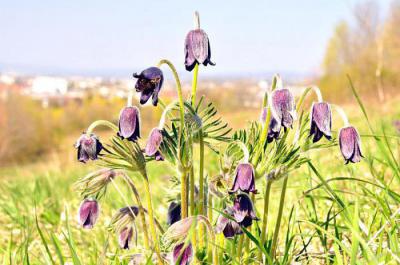

For those who are poorly versed in herbal treatment, it is better to consult a specialist. In addition to its healing properties, if used improperly, the herb can harm health, especially meadow lumbago, which contains a huge list of toxic substances.
The herb is known in China, Bulgaria and many other countries. A powder is made from meadow lumbago that can heal wounds and burns. Also, the plant is an excellent remedy in the fight against acne and other skin diseases (boils, acne, blackheads). The main thing is to use it according to the recommendations. It is advised to use the plant for people with gout and often suffering from a rash with purulent acne.
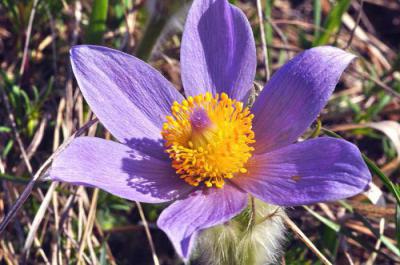

SHOT MEADOW
Meadow lumbago (Pulsatilla pratensis) is found in Central and Eastern Europe, Scandinavia, in the west of European Russia.
Plant up to 30 cm tall. It blooms simultaneously with the appearance of leaves, in late April - early May. The flowers are medium-sized, bell-shaped, drooping, purple or brownish. Looks decorative in fruits thanks to the lush, heavily dissected foliage.
The flowers of this species are small, but very graceful.They hang from gracefully curved pedicels that end on relatively tall stems, giving the impression of touching and defenseless.
OUR ADVICE
Sleep grass is a light-loving plant; it is best placed in areas with light partial shade or completely open. The soil requires fertile, deeply cultivated, well-drained. Lumbago does not tolerate stagnant moisture.
Before planting, it is useful to add a little lime and nitrogen fertilizer to the soil. Lumbago responds well to phosphorus-potassium supplements (ash, bone meal), which are carried out several times during the budding period, after flowering and fruiting.
Application in traditional medicine
Due to its unique composition, an open lumbago, or a dream herb, has been widely used in folk medicine. The Red Book, where it was entered not so long ago, limits its collection. Basically, the herb is used as a hypnotic and sedative. But this is not the only direction. Also, sleep-grass has a powerful bactericidal, antifungal and expectorant effect.
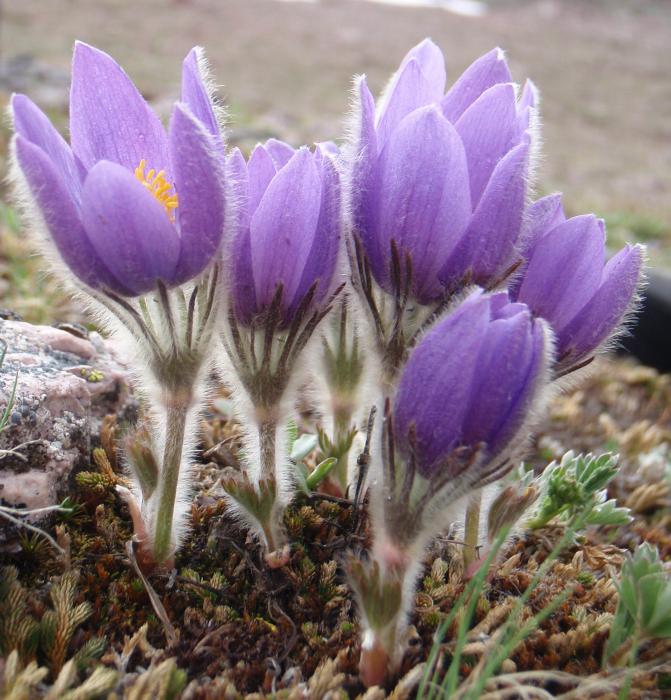

This type of lumbago has an antipyretic and diuretic effect. In traditional medicine recipes, herb is used to warm sore joints of the limbs over brewed herbs. Turchaninov's lumbago, which grows in Transbaikalia, as well as Daurian, which can be found in Primorye and the Amur Region, is used to treat pustular infections, as an analgesic, distracting agent and to restore strength when the body is depleted.
The open lumbago is suitable for rubbing the squeezed juice of the greens of the inflamed rheumatic joints. Still fresh juice heals from glaucoma. Another species - drooping lumbago growing in the east of the country - has found its application in Chinese medicine. Decoctions of mature rhizomes are used as a hemostatic and astringent.
Naturally, before using the miraculous properties of lumbago, you need to get professional advice from a doctor. There are also certain contraindications associated with the fact that the plant is poisonous. In particular, in the presence of diseases such as gastritis and other pathologies of the gastrointestinal tract, nephritis. The medicinal collection is carried out during the flowering period of the sleep-grass, which lasts from April to May.
Since all types of lumbago have an incredibly attractive appearance, they look organically in group landscape plantings and will be an excellent decoration for lawns, alpine slides and park areas. And for those who wish to dig up a rare and forbidden wild-growing specimen of a flower open lumbago for their garden, information that adult lumbago cannot tolerate transplanting will be useful.
| Lumbago uncovered | |
| Scientific classification |
| Domain: | Eukaryotes |
| Kingdom: | Plants |
| Subkingdom: | Green plants |
| The Department: | Flowering |
| Class: | Dicotyledons [1] |
| Superorder: | Ranunculanae Takht. ex Reveal, 1993 |
| Order: | Buttercup |
| Family: | Buttercup |
| Subfamily: | Buttercup |
| Tribe: | Anemone |
| View: | Lumbago uncovered |
In Russian poetry, sleep-grass is most often referred to as a sleeping pill, apparently because of its name, or serves as a harbinger of the onset of spring and the awakening of nature, as, for example, in a poem by A.K. Tolstoy:
With what pure joy I again met in the forest with cheese A blue and fluffy jug With its shaggy stalk ...
or among the poets of the 20th century, for example, in A. V. Zhigulin's poem "Sleep-grass" (1957):
Put me to sleep, sleep-grass, At the edge of a dry forest.
There is often a mention of sleep-grass in prose. A. I. Kuprin writes in the story "Olesya":
The large bells of "sleep", the first flower of Polesye, raised their purple heads. Large simple flowers bearing the poetic name "sleep" ("Black Mist") were blue on the embankment.
- What a delight! ... Purple dream! Between her palms, the bells of lilac sleep, covered with thick silver fluff, bloomed on the ground.
In modern fantasy, like M. Kaddat in The Tales of Gil de Vinter, dream-grass personifies the dark forces of magic and nature:
... This beast was painted on the coats of arms of the royal family until the time when the dukes of Erythrine did not take for themselves this symbol of royal power by force, and their coat of arms is a dream-herb, popularly called a witch's potion. No one had painted this flower on the family banner before them, and therefore its meaning in heraldry is not known. Others say that the castle of their ancestral Gil-de-Winter is compared with a dream-grass, allegedly he grew up himself, drawn by some unclean force, rose from the depths of the sea.
Typical lumbago open (Pulsatilla patens) grows in meadow steppes, pine forests, on dry slopes in the countries of central and northern Europe, almost throughout the European part of Russia, in Western Siberia.
Open backache (Pulsatilla patens)
It has palmate-dissected leaves and flowers in purple tones and rather wide leaf lobes. But along the boundaries of the range, there are all sorts of anomalies, which often receive the status of a species and their own names. In the north-west, in Karelia, open lumbago meets with spring lumbago (P. vernalis), which is characterized by a feathery wintering leaf and protruding flowers. From the inside they are white, and from the outside they can be yellowish, pinkish, lilac. Hybrids called P. x intermedia, i.e. lumbago intermediate, are variably colored and inherit the leaves of one or the other parent. Themselves are considered sterile.
In the eastern part of the range, open lumbago undergoes large-scale transformations
Particularly interesting and large-scale transformations occur with this lumbago in the eastern part of its range. As the saying goes, “our lumbago has ripened everywhere” ... Starting from the Volga regions, specimens with finely dissected leaves and yellowish flowers begin to be found in its populations more and more often.
In the Urals, there are shots of various colors
In the Urals, there is already a fireworks display of various colors: white, yellowish, pink, blue, and all this can be seen in one glade. In Eastern Siberia up to Kamchatka, only finely dissected leaves are found in populations, which made it possible to distinguish such species as narrow-leaved lumbago, or divisible (P. multif> In different regions, one or another color predominates, and the most beautiful bright yellow flowers can be found in Tuva. The confusion that is observed in the Urals is considered the result of the meeting of European and Siberian lumbago and was given a specific name - Ural lumbago (P. uralensis).
Open lumbago (Pulsatilla patens) and yellow lumbago (P. flavescens)
But if you look at the matter informally, then you can consider them as geographical races. lumbago uncovered, which were isolated as it moved to the east. That is, different options were tested when meeting new conditions and the most suitable ones were selected. By the way, the Americans believe that the lilac placers, which adorn the dry prairies of their continent from Mexico to Alaska in spring, create precisely the open chamber, although their plants have finely dissected leaves.
How to rejuvenate
In one place, lumbago grows up to 10 years, then the plant begins to age, the central root collapses, and the specimen gradually disintegrates into separate bushes. A similar process can be observed with garden strawberries. The new plants obtained in this way can be transplanted, but it is preferable to rejuvenate the plantings and replace the old lumbago with a new one grown from seeds.
Caring for sleep-grass is simple and comes down to regular weeding and watering during dry periods.
Lumbago is practically not susceptible to disease and pest attacks
slightly shading is recommended. Seeds germinate in 3-4 weeks, hot weather in combination with watering contributes to rapid growth. Experts recommend sprinkling crops with a thin layer of hay - this retains moisture in the soil and protects seedlings from sudden temperature changes. If there is little seed, sowing is best done in pots or boxes. Sowing in a container is good because it can be started in early spring, in March-April, in a greenhouse or on a windowsill.
Landing lumbago
Before planting a lumbago, it is imperative to improve the soil.Organic fertilizers are introduced into it - compost, humus, as well as a little nitrogen fertilizers (for example, urea). Then a thorough digging is carried out. Since the dream-grass has very deep tap roots, the processing must be carried out at a great depth. For all shots, except for spring shots, lime should be added to the soil or at least slightly alkaline soil should be chosen.
You can carry out the transfer of plants from the seed beds in early spring. But seedlings in a permanent place can be planted from May until the end of summer (but early planting also gives the best results).
When planting a plant, it is necessary to completely preserve the earthen lump, try to reduce contact with the plant to a minimum. It is critically important to provide thorough care for the lumbago: during the first month, or better before the active development of the lumbago, it is necessary to actively water (but without excessive dampness).
Lumbago does not tolerate transplantation very well. Plants over 10 years old are unlikely to survive a change of location. But on the other hand, the lumbago does not need divisions, a constant change of the growing place. If there is a need for reproduction or transplantation, the lumbago is dug out with a large lump of earth, keeping it completely during the procedure.
Collection and storage tips
When using meadow lumbago, one should not forget about its toxicity and toxic substances. To do this, you must follow all the rules and recommendations for use. The most important thing is that only the ground part of the herb is used for medicinal purposes. Moreover, it can be stored for no longer than six months. Collect the lumbago only in the middle of spring. In the summer, there is nothing useful in the grass, but rather the opposite. If you do not take into account such information, then you can not cure the disease, but further worsen the condition of the body.
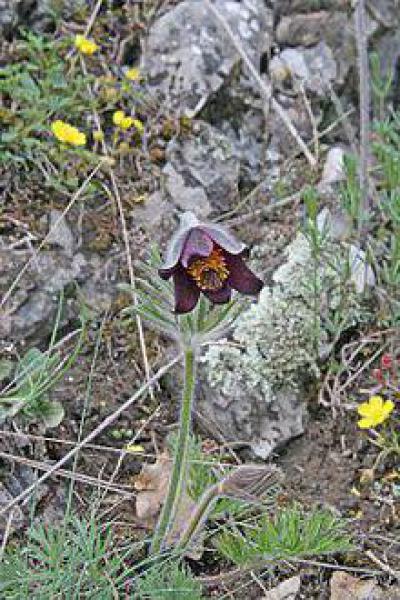

Recipes for making a safe medicine with meadow lumbago:
- Tincture. Approximately 50 grams of dry grass is poured into a standard glass of boiling water. The herb should be infused for about an hour, after which it should be filtered with gauze or bandage. The recommended dosage is one tablespoon. It should be consumed one hour before meals no more than four times a day. Treatment with such a tincture can last from several weeks to months.
- Baths with a decoction of sleep-herbs. For cooking, you will need about 200 grams of dry meadow lumbago and one and a half liters of boiling water. The longer it is infused, the better. You can prepare the solution in advance. For example, for an evening bath, it is better to cook the broth in the morning. Such baths help with various dermatological diseases, fungi, thrush in women.
- Alcohol tincture. It is prepared very quickly and easily. You will need 20 grams of grass and 200 ml of vodka. It should stand in a dark place for about a week. Apply the resulting tincture only externally. Good for arthritis and rheumatism.
The effectiveness of this herb in the treatment of Staphylococcus aureus (one of the most dangerous and difficult bacteria for the human body) has been proven. In traditional medicine, it is only treated with a long course of antibiotics. Naturally, herbal treatment may be safer and not have a bad effect on other organs.
The name of the plant and the legends about it
In addition to the name "sleep-grass" perennial from the Buttercup family has other names - it is called the open anemone, lumbago. A legend is associated with each of the names explaining its origin.
Lumbago
This story happened a long time ago, when the plant, the current lumbago, had beautiful wide leaves. Satan, expelled from Paradise, often used the leaf as a shelter, biding his time there for his dirty deeds. Archangel Michael did not like the news of this and, waiting for the moment when the evil spirits climbed into the shelter, he threw heavenly thunder and lightning into the flower.From the blow of the elements, the leaf turned into thin long stripes, depriving Satan of his favorite place. Since then, the flower has been called "lumbago", and all the evil spirits try not to approach it.
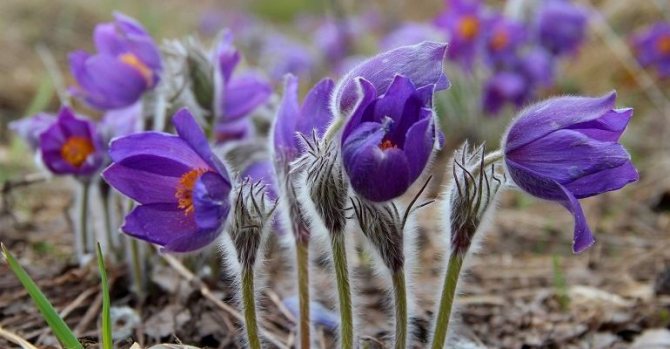

Dream herb
Once a man went to the forest and noticed that a bear was digging in the ground in a forest glade. He took out some root, ate it and immediately fell asleep in the den. The man decided to taste the root and also fell asleep after licking it. The rays of the bright sun woke him up. He went home, not suspecting that a long time had passed. The villagers, seeing him, marveled, poked their fingers at him, and those at home had already lit a candle for the commemoration of the soul. They called the guests, set the table and listened to the story of the "lost". It turns out, as the witch doctor explained to him, he licked the root of a herb that has sleepy properties. This is how the name "sleep-grass" appeared.
Anemone
The name "anemone" is popularly explained by the calm nature of the plant, which loves warmth, sun, peace after the winter cold, and shudders at any, even very weak, breeze.
Location
Lumbago does not tolerate heavy and moist soils with an acid reaction. In nature, it grows on mountain slopes, on sandy and stony soil, with a high content of chalk or lime. In a garden, a good soil composition for lumbago: coarse sand (vermiculite, fine gravel) and sod land in equal proportions, with the addition of good humus (one fourth of the total volume) and a complex of mineral fertilizers for snowdrops.
The lumbago grows equally well in sunny meadows and in the lacy shade of trees. It is better to choose slopes for it, facing east or south.
Synonyms [edit | edit code]
The synonyms of the species include the following names [4]:
- Anemone hirsutissima
MacMill. - Anemone intermedia
G.Don - Anemone longipetala
Schleich. ex Steud. - Anemone ludoviciana
Nutt. - Anemone nuttalliana
DC. - Anemone nuttallii
Nutt. - Anemone patens
var.
hirsutissima
(Britton) Hitchc. - Anemone patens
var.
nuttalliana
(DC.) A.Gray - Anemone patens
var.
rosea
Cockerell - Anemone patens
f.
stevensonis
B. Boivin - Anemone patens
var.
wolfgangiana
(Besser) Koch - Anemone pulsatilla
var.
patens
(L.) Finet & Gagnep. - Anemone wolfgangiana
Besser - Pulsatilla bauhinii
Tausch ex Pritz. - Pulsatilla kioviensis
Wissjul. - Pulsatilla nuttalliana
(DC.) Spreng. - Pulsatilla patens
(L.) Mill., 1768 - Pulsatilla patens
f.
albiflora
X.F.Zhao ex Y.Z.Zhao - Pulsatilla patens
subsp.
hirsutissima
Zämelis - Pulsatilla patens
var.
kioviensis
(Wissjul.) Tzvelev - Pulsatilla patens
var.
wolfgangiana
(Besser) Trautv. & C.A.Mey. - Pulsatilla pseudopatens
Schur - Pulsatilla teklae
Zämelis - Pulsatilla wolfgangiana
(Besser) Rupr.

